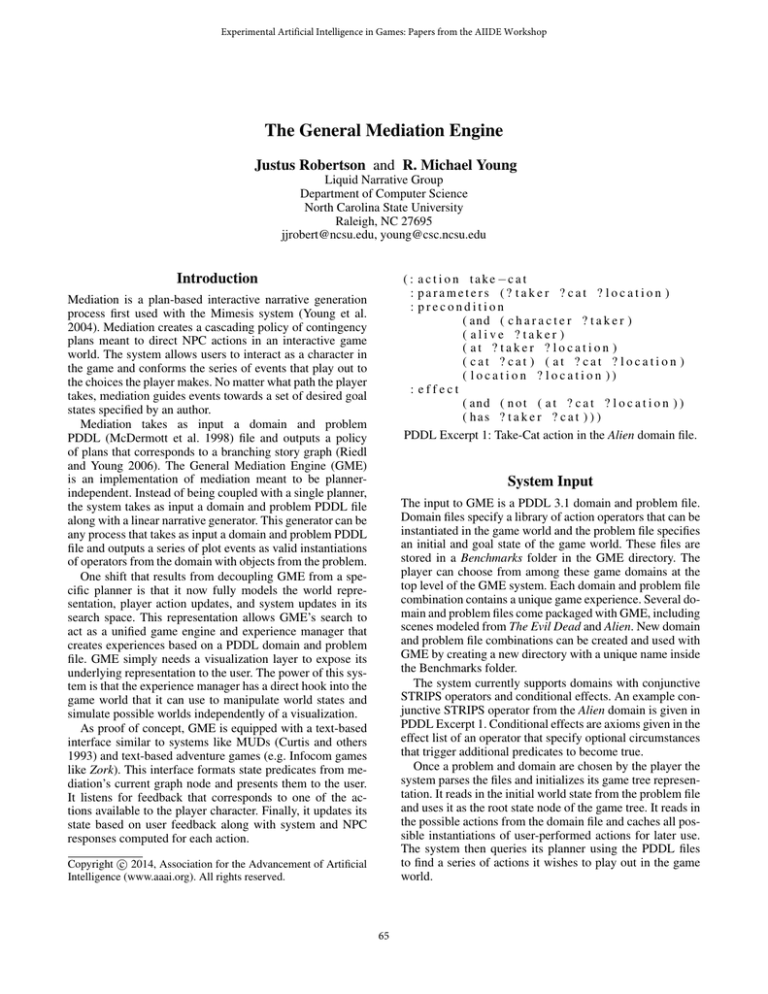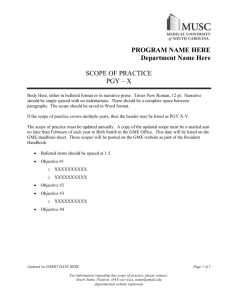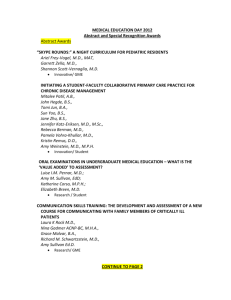
Experimental Artificial Intelligence in Games: Papers from the AIIDE Workshop
The General Mediation Engine
Justus Robertson and R. Michael Young
Liquid Narrative Group
Department of Computer Science
North Carolina State University
Raleigh, NC 27695
jjrobert@ncsu.edu, young@csc.ncsu.edu
Introduction
( : a c t i o n t a k e −c a t
: parameters (? taker ? cat ? location )
: precondition
( and ( c h a r a c t e r ? t a k e r )
( alive ? taker )
( at ? taker ? location )
( cat ? cat ) ( at ? cat ? location )
( location ? location ))
: effect
( and ( n o t ( a t ? c a t ? l o c a t i o n ) )
( has ? t a k e r ? c a t ) ) )
PDDL Excerpt 1: Take-Cat action in the Alien domain file.
Mediation is a plan-based interactive narrative generation
process first used with the Mimesis system (Young et al.
2004). Mediation creates a cascading policy of contingency
plans meant to direct NPC actions in an interactive game
world. The system allows users to interact as a character in
the game and conforms the series of events that play out to
the choices the player makes. No matter what path the player
takes, mediation guides events towards a set of desired goal
states specified by an author.
Mediation takes as input a domain and problem
PDDL (McDermott et al. 1998) file and outputs a policy
of plans that corresponds to a branching story graph (Riedl
and Young 2006). The General Mediation Engine (GME)
is an implementation of mediation meant to be plannerindependent. Instead of being coupled with a single planner,
the system takes as input a domain and problem PDDL file
along with a linear narrative generator. This generator can be
any process that takes as input a domain and problem PDDL
file and outputs a series of plot events as valid instantiations
of operators from the domain with objects from the problem.
One shift that results from decoupling GME from a specific planner is that it now fully models the world representation, player action updates, and system updates in its
search space. This representation allows GME’s search to
act as a unified game engine and experience manager that
creates experiences based on a PDDL domain and problem
file. GME simply needs a visualization layer to expose its
underlying representation to the user. The power of this system is that the experience manager has a direct hook into the
game world that it can use to manipulate world states and
simulate possible worlds independently of a visualization.
As proof of concept, GME is equipped with a text-based
interface similar to systems like MUDs (Curtis and others
1993) and text-based adventure games (e.g. Infocom games
like Zork). This interface formats state predicates from mediation’s current graph node and presents them to the user.
It listens for feedback that corresponds to one of the actions available to the player character. Finally, it updates its
state based on user feedback along with system and NPC
responses computed for each action.
System Input
The input to GME is a PDDL 3.1 domain and problem file.
Domain files specify a library of action operators that can be
instantiated in the game world and the problem file specifies
an initial and goal state of the game world. These files are
stored in a Benchmarks folder in the GME directory. The
player can choose from among these game domains at the
top level of the GME system. Each domain and problem file
combination contains a unique game experience. Several domain and problem files come packaged with GME, including
scenes modeled from The Evil Dead and Alien. New domain
and problem file combinations can be created and used with
GME by creating a new directory with a unique name inside
the Benchmarks folder.
The system currently supports domains with conjunctive
STRIPS operators and conditional effects. An example conjunctive STRIPS operator from the Alien domain is given in
PDDL Excerpt 1. Conditional effects are axioms given in the
effect list of an operator that specify optional circumstances
that trigger additional predicates to become true.
Once a problem and domain are chosen by the player the
system parses the files and initializes its game tree representation. It reads in the initial world state from the problem file
and uses it as the root state node of the game tree. It reads in
the possible actions from the domain file and caches all possible instantiations of user-performed actions for later use.
The system then queries its planner using the PDDL files
to find a series of actions it wishes to play out in the game
world.
c 2014, Association for the Advancement of Artificial
Copyright Intelligence (www.aaai.org). All rights reserved.
65
Figure 1: A possible state in the Alien domain.
Game Tree Expansion
Demo
Once the current state information is prepared, the system
begins expanding its game tree representation. It checks to
see what cached player actions have their preconditions fulfilled by the initial state. For each valid player action the
system expands the graph by computing a system response,
updating the state representation, and creating a new game
tree node. This graph expansion process is done on-line in
conjunction with a set of knowledge axioms and a text interface that expose state information and possible player actions to the user. The system expands the graph, takes NPC
action, and updates state information based on what actions
the player takes in the interface.
The system currently uses the Fast Downward (Helmert
2006) planner to construct narrative trajectories, but with
minor changes can support any planner that takes PDDL 3.1
input through a command line call and outputs plans as a
series of fully ground operators from the input domain.
An early demo of GME with installation and usage instructions can be found at:
http://go.ncsu.edu/gme
Conclusion
The General Mediation Engine is a game engine and experience manager that uses PDDL domain and problem files
to generate gameplay. This system is interesting because it
provides an experience manager direct access to world states
and actions that can be manipulated independently of the visual experience. The system currently uses a text-based interface to expose its internal representation to the user. This
visual layer may later be substituted for more robust 2D or
3D graphical models.
References
Curtis, P., et al. 1993. LambdaMOO Programmers Manual.
Xerox Parc.
Helmert, M. 2006. The Fast Downward Planning System.
Journal of Artificial Intelligence Research 26:191–246.
McDermott, D.; Ghallab, M.; Howe, A.; Knoblock, C.; Ram,
A.; Veloso, M.; Weld, D.; and Wilkins, D. 1998. PDDL The Planning Domain Definition Language.
Riedl, M. O., and Young, R. M. 2006. From Linear Story
Generation to Branching Story Graphs. Computer Graphics
and Applications 26(3):23–31.
Young, R. M.; Riedl, M. O.; Branly, M.; Jhala, A.; Martin,
R. J.; and Saretto, C. J. 2004. An Architecture for Integrating Plan-Based Behavior Generation with Interactive Game
Environments. Journal of Game Development 1(1):51–70.
Interface
The system exposes state information and receives player
actions through a text-based interface. The system is
equipped with interchangeable observation axioms that filter the full world state according to what the player can
see. It also has natural language formatting rules that output observed state predicates in English sentences instead
of the underlying logical formalism. The interface accepts
commands from users that correspond to enabled PDDL actions from the domain. The system supports a shorthand for
specifying actions by typing the action name and a number
of trailing variables that correspond to ’-’ symbols in the action title. So, instead of typing (move-location player outside
house) a user can type move outside to specify the action.
66








